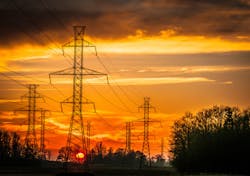Fiber-Through-the-Grid (FTT-Grid™): Pioneering the Future of Grid Modernization
The power grid, a marvel of engineering when initially built, now stands at a pivotal crossroads in its history, faced with unprecedented demands for growth and innovation. Built in an era when both power and connectivity demands were considerably lower, it is now grappling with the surging needs of our modern world, the demands of which are only expected to escalate.
An aging infrastructure, the ever-present impacts of climate change, and the imperative to support renewable energy sources and electric vehicles all loom large on the horizon. With the electrify-everything movement sweeping through society, the grid is under pressure to keep pace with escalating demand while simultaneously managing and modernizing its aging infrastructure. To navigate this complex landscape, the solution lies in threading more fiber deep within the grid. However, this endeavor is far from straightforward, as it involves tackling environmental challenges, mechanical intricacies, and electrical complexities, with investments that need to be thought of as generational in scope.
Preparing for the grid’s future needs
Incentives often push utilities to invest heavily in infrastructure rather than emerging technologies, potentially resulting in overinvestment in physical assets instead of digital solutions. Utilities must carefully weigh their decisions to ensure profitability and effective capital utilization while navigating inflationary challenges and the mounting costs of energy production. Regulatory complexities, particularly pertaining to the construction of transmission lines and support for renewable energy, further complicate the grid’s modernization, especially in the context of interregional transmission lines crossing state lines.
The intersection of these trends underscores the need for a multifaceted and robust communication network that meets regulatory requirements, supports network control, and provides broadband capabilities amidst myriad challenges.
Modernizing the grid: the need for communication
Modernizing the grid involves deploying additional devices to monitor and respond to grid conditions, especially with the proliferation of behind-the-meter smart devices, necessitating a communication network that can handle increased data flows. Fiber emerges as the ideal medium to meet these challenges, facilitating a robust, low-latency, high-bandwidth network capable of addressing evolving requirements, accommodating the convergence of various communication networks, and enhancing grid efficiency.
Furthermore, fiber provides enhanced security, being less vulnerable to breaches compared to wireless alternatives. Its symmetrical data speeds ensure optimal performance, making it an essential element for future-proofing the grid. This concept, known as “Fiber-Through-the-Grid (FTT-Grid™),” offers the flexibility, extensibility, and future accessibility required to support the grid’s evolving needs.
Building a fiber-deep network
AFL’s approach to FTT-Grid is the linchpin to modernizing transmission and distribution infrastructure. It equips utilities to address immediate challenges while preparing for an unbounded future with long-term, low-overhead improvements. The advantages of fiber, including symmetrical data speeds, heightened network efficiency, and robust security against vulnerabilities like electromagnetic pulse attacks, make it indispensable for a fiber-deep network designed to support low-latency, high-bandwidth applications that stand the test of time.
Across the fiber industry, the relentless march of innovation continues, driven by the needs of telecom, utilities, and data centers. Advances in fiber technology include reducing fiber size, enabling more bandwidth-dense cables, and introducing ribbonized fiber for mass fusion splicing. These innovations translate to lower operations and maintenance costs and greater network capacity, ensuring the grid remains adaptable. Additional innovations in hardware and deployment strategies, such as Aerial All-Dielectric Self-Supporting (ADSS) cable technology, allow utilities to efficiently utilize their right of way and deploy fiber deeper into the grid, enabling a resilient and future-ready communication network.
Leading the way in fiber solutions
AFL has been at the forefront of providing fiber optic solutions for electric utilities for four decades. Our unwavering focus on the future drives us to provide an all-encompassing suite of fiber optic solutions that help utilities embed fiber deep within their networks, catering to current and future requirements. By extending fiber connections from power plants to homes and businesses, we make the grid smarter, more resilient, and better prepared to predict and respond to demand. Our vision for grid modernization involves deeper communication, connecting with more endpoints and inline devices, all facilitated through the widespread deployment of fiber optic cables to enhance connectivity, and our solutions are meticulously designed to meet both present and future needs, ensuring a lasting investment and future-proofing the grid.
The concept of a SAFER™ network
Given the ever-changing landscape of technology and energy demands, network and grid operators must design for both today’s challenges and those of the future. To improve operational performance, ensure grid resiliency and reliability, and plan for future demands, we introduce the concept of a “SAFER” network — one that is sustainable, accessible, flexible, expandable, and reliable.
With fiber as the core component of grid modernization, we recognize that the only certainty is the uncertainty of future challenges. To deploy new smart grid technologies, a broadband network is a key foundation, making it essential to deploy fiber that offers expandability, accessibility, and reliability to meet these evolving demands.
Conclusion
The power grid is at a critical juncture, facing an array of challenges and uncertainties, and deploying fiber deep into the grid, as part of a SAFER network, will be crucial to ensuring capacity. This approach ensures the grid is sustainable, accessible, flexible, expandable, and reliable, preparing it for a future marked by ever-evolving energy demands and technological advances. Fiber-Through-the-Grid is the key to modernizing the grid and making it future-ready. AFL is committed to providing the necessary solutions for this transformative journey.
Sponsored by:

